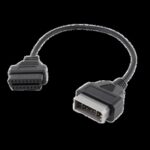Dealing with an airbag light on your BMW can be concerning. It indicates a potential issue with your Supplemental Restraint System (SRS), which is crucial for safety. While modern vehicles often require professional diagnostics, owners of older BMW models, particularly those from the 1990s and early 2000s, might consider using an OBD2 scanner to address this issue. This article explores using OBD2 scanners for airbag light problems in older BMWs, focusing on tool compatibility and what you need to know.
Understanding OBD2 Scanners for Airbag Lights
An OBD2 scanner is a tool used to communicate with your car’s computer system. It can read diagnostic trouble codes (DTCs), which can help pinpoint the cause of various problems, including issues that trigger the airbag light. For older BMWs, specifically those manufactured roughly between 1994 and the early 2000s, certain scanners can be effective in diagnosing and sometimes resetting the airbag light. However, compatibility is a key factor to consider.
Compatibility Challenges with Pre-1994 BMW Models
It’s crucial to understand that OBD2 scanner compatibility for airbag systems isn’t universal across all BMW models, especially older ones. Tools designed for BMW airbag system reset, like the Peake SRS tool and the inexpensive B800 SRS reset tool often found online, generally work with BMWs built from 1994 onwards. Models manufactured before 1994 typically use different diagnostic systems that are not compatible with these OBD2 based tools. Therefore, if you own a BMW older than 1994, these standard OBD2 airbag reset tools are unlikely to work for you.
Popular OBD2 Airbag Reset Tools: Peake SRS and B800
For BMWs built within the 1994-2002/2003 timeframe, tools like the Peake SRS tool have been popular. The manufacturer themselves state compatibility for “most BMWs built between 1994 and 2002,” but also note reduced compatibility around mid-2002 and for flagship models like the 7 Series. Similarly, the B800 SRS reset tool, a more budget-friendly option, generally operates within a similar year range. Experience shows these tools may not function on BMWs older than 1994, but can be effective on models within the specified range, such as a 1998 E36 M3, for reading fault codes and resetting the SRS light after a repair.
Diagnostic Ports: 20-Pin vs. OBD2
Another important point for owners of older BMWs is the diagnostic port location. Some BMWs from this era have both a 20-pin round diagnostic connector in the engine bay and a standard OBD2 port near the steering wheel. For airbag system diagnosis and reset, it’s often necessary to use the 20-pin diagnostic port in the engine bay, even if an OBD2 port is present. The OBD2 port in these older models is often primarily for engine-related diagnostics, while systems like the SRS might be accessed through the 20-pin port. This applies to tools like the SIR3, BOA, and B800.
Watch Out for Misleading Product Descriptions
When searching for OBD2 airbag reset tools, particularly online, be cautious of misleading product descriptions. Some listings might broadly advertise compatibility with various BMW models (e.g., E36, E46, E34, E38, E39, Z3, Z4, X5) without clearly stating the crucial year range limitation (1994-2003). While these model designations are correct, these models were also produced before 1994. Always carefully read the full product description to confirm the specific year range compatibility to avoid purchasing a tool that won’t work with your older BMW.
Conclusion
For BMW owners dealing with an airbag light, an OBD2 scanner can be a helpful tool, especially for models built from 1994 to the early 2000s. Tools like the Peake SRS and B800 have been used to diagnose and reset SRS lights on these vehicles. However, pre-1994 BMWs are generally not compatible with these tools. Remember to verify tool compatibility with your specific BMW model year and be aware of the diagnostic port location. Always prioritize safety; if you are unsure about diagnosing or repairing your airbag system, consult a qualified automotive technician.
